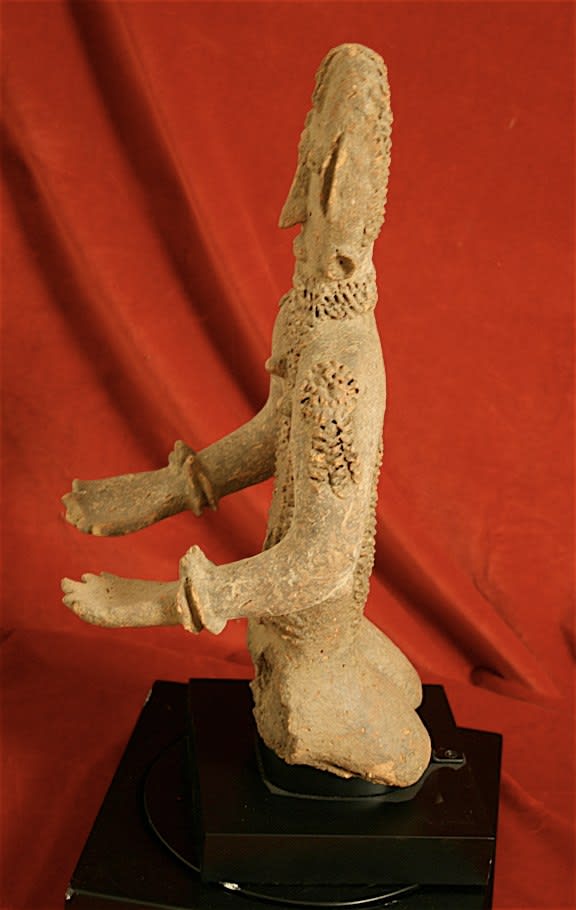Bura Terracotta Sculpture, 3rd Century CE - 11th Century CE
Terracotta
PF.1496 (LSO)
This dynamic terracotta figure of a seated man was made by one of Africa’s most inscrutable groups, the Bura. It comprises a fairly flat-figured torso with extensive scarifications, giving rise...
This dynamic terracotta figure of a seated man was made by one of Africa’s most inscrutable groups, the Bura. It comprises a fairly flat-figured torso with extensive scarifications, giving rise to broad shoulders and arms that curve around to the front with hands flared, giving the semblance of a drummer. The legs are truncated at the top of the thighs. The neck is short, with a flat face, bearing the traditional crested nose, coffee-bean eyes and scarifications to temples and forehead. The neck is ringed with necklaces and the arms bear scarifications; the navel is surrounded with a scar pattern that recalls Senufo designs. The sex of the figure is ambiguous but it may be female based upon the small breast-like appendages.
The Bura are a true paradox: almost nothing is known of this shadowy Nigerian/Malian group. They appear to have originated in the first half of the first millennium AD, although the only archaeologically-excavated site (Nyamey) dates between the 14th and 16th centuries. They are contemporary with the Djenne Kingdom, the Koma, the Teneku and a satellite culture known as the Inland Niger Delta, and, like them, have extensive ceramic and stone sculptural traditions.
The Bura were sedentary agriculturists who buried their dead in tall, conical urns that were often decorated with incisions, and sometimes surmounted by small figures. Their best-known art form is radically reductivist anthropomorphic stone statues, with heads rendered as squares, triangles and ovals, with the body suggested by a columnar, monolithic shape beneath. This form finds fuller expression in phallomorphic objects that may have been staffs, perhaps regalia pertaining to leaders. Complex ceramic heads are also known, with incised decoration and variable treatment of facial proportions and features. There are a few very rare equestrian figures: these bear some resemblance to Djenne pieces.
The social role of these figures is uncertain. Equestrian figures probably represent high status individuals, and the very few full-body representations of humans may be portraits or ancestor figures. One might expect figures with exaggerated sexual characteristics to be associated with fertility and fecundity, as would any artefact modelled in the shape of pudenda. The one-sided distribution of decoration on staffs and phalluses may suggest that they were designed to be viewed from one angle only – perhaps as adorational pieces.
This outstanding Bura piece is unusually complex, and is a striking and attractive piece of ancient art from one of Africa’s great lost civilisations.
The Bura are a true paradox: almost nothing is known of this shadowy Nigerian/Malian group. They appear to have originated in the first half of the first millennium AD, although the only archaeologically-excavated site (Nyamey) dates between the 14th and 16th centuries. They are contemporary with the Djenne Kingdom, the Koma, the Teneku and a satellite culture known as the Inland Niger Delta, and, like them, have extensive ceramic and stone sculptural traditions.
The Bura were sedentary agriculturists who buried their dead in tall, conical urns that were often decorated with incisions, and sometimes surmounted by small figures. Their best-known art form is radically reductivist anthropomorphic stone statues, with heads rendered as squares, triangles and ovals, with the body suggested by a columnar, monolithic shape beneath. This form finds fuller expression in phallomorphic objects that may have been staffs, perhaps regalia pertaining to leaders. Complex ceramic heads are also known, with incised decoration and variable treatment of facial proportions and features. There are a few very rare equestrian figures: these bear some resemblance to Djenne pieces.
The social role of these figures is uncertain. Equestrian figures probably represent high status individuals, and the very few full-body representations of humans may be portraits or ancestor figures. One might expect figures with exaggerated sexual characteristics to be associated with fertility and fecundity, as would any artefact modelled in the shape of pudenda. The one-sided distribution of decoration on staffs and phalluses may suggest that they were designed to be viewed from one angle only – perhaps as adorational pieces.
This outstanding Bura piece is unusually complex, and is a striking and attractive piece of ancient art from one of Africa’s great lost civilisations.
